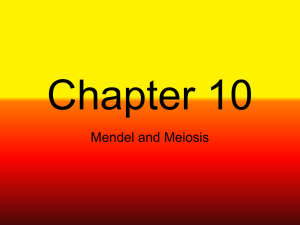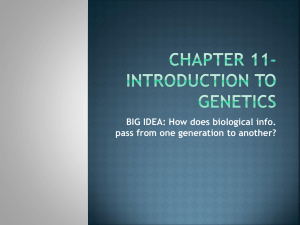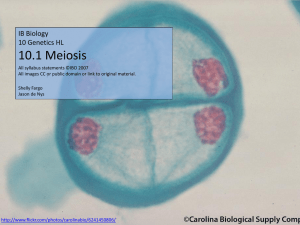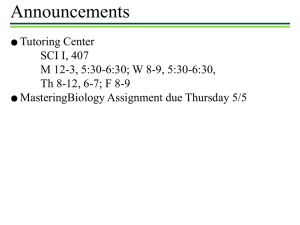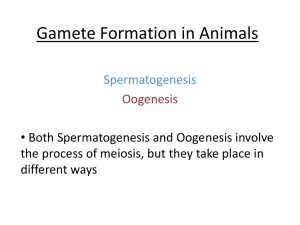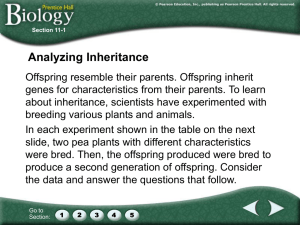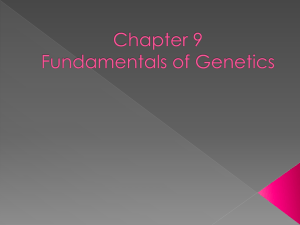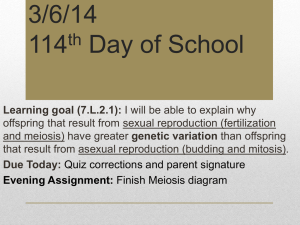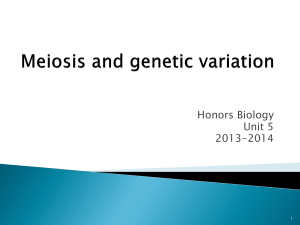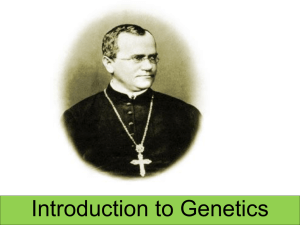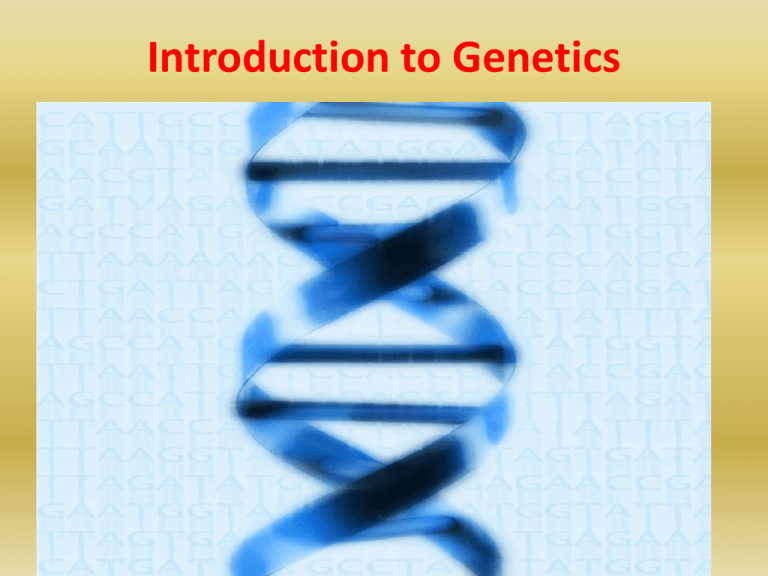
Introduction to Genetics
The Work of Gregor Mendel
• Genetics: The scientific study of heredity. (Is now at the core of a
revolution in understanding biology.)
• Gregor Mendel: Was an Austrian Monk, who was in charge of the
monastery garden. He was the first person to trace the characteristics
of successive generations of a living thing (pea plants).
• Mendel noticed while doing his work in the gardens, that part of each
flower produces pollen, which contains the plant’s male reproductive
cells, or sperm. Similarly, the female portion of the flower produces
egg cells.
• During sexual reproduction, male and female reproductive cells join,
in a process known as fertilization. Fertilization produces a new cell,
which develops into a tiny embryo encased within a seed.
Mendel’s Genetics
• Mendel’s pea plants were true-breeding, meaning that if
they were allowed to self pollinate, they would produce
offspring identical to themselves.
• Mendel wanted to form different pea plants other than his
true-breeding plants so he cross pollinated his pea plants
by joining male and female reproductive cells from
different plants.
Cross Pollination
Mendel’s Genetics
• Mendel studied 7 different pea
plant traits
• Trait: a specific characteristic,
such as seed color or plant
height, that varies from one
individual to another.
• Hybrids: are the offspring of
crosses between parents with
different traits
• P= parental generation
• F1= 1st son or daughter
generation (1st offspring)
Mendel’s Seven F1 Crosses
on Pea Plants
Seed
Shape
Seed
Color
Round
Yellow
Seed Coat
Color
Pod
Shape
Pod
Color
Flower
Position
Gray
Smooth
Green
Axial
Tall
Short
Wrinkled
Green
White
Constricted
Yellow
Terminal
Round
Yellow
Gray
Smooth
Green
Axial
Plant
Height
Tall
Mendel’s Conclusions From His Experiments
1st: was that biological inheritance is determined by
factors that are passed from one generation to the
next. (Scientist, call the chemical factors that
determine traits genes.)
2nd: Principal of dominance: states that some alleles
are dominant and others are recessive. (Alleles:
different forms of a gene)
3rd: During gamete formation, alleles segregate from
each other so that each gamete (sex cells) carries
only a single copy of each gene. Each F1 plant
produces two types of gametes- those with the allele
for tallness and those with the allele for shortness
Genetic Material
Alleles
Principles of Dominance
P Generation
Tall
F1 Generation
Short
Tall
Tall
F2 Generation
Tall
Tall
Tall
Short
Probability and Punnett Squares
• Probability: The likelihood that a particular event will
occur.
-Ex. Flipping a coin
• The principals of probability can be used to predict the
outcomes of genetic crosses.
• Punnett Squares: used to predict and compare the
genetic variations that will result from a cross
– Homozygous: Organisms that have 2 identical alleles
for a particular trait “TT or tt” (true-breeding)
– Heterozygous: Organisms that have 2 different alleles
for the same trait “Tt” (hybrid)
– Phenotype: physical characteristics (Ex. tall plants)
– Genotype: genetic makeup (Ex. TT or Tt)
Punnett Square
Exploring Mendel’s Genetics
• The Two-Factor Cross:F1 Mendel crossed plants that were
homozygous dominant for round yellow peas with plants that were
homozygous recessive for wrinkled green peas. (All of the F1
offspring were heterozygous dominant for round yellow peas.) p.270
• The Two-Factor Cross:F2 When Mendel crossed plants that were
heterozygous dominant for round yellow peas, he found that the
alleles segregated independently to produce the F2 generation.
• Independent Assortment: independent segregation of genes
during the formation of gametes (The Principal of Independent
Assortment)
– Accounts for the many genetic variations observed in plants,
animals, and other organisms.
Independent Assortment in Peas
Shared Traits
• Some alleles are neither dominant nor recessive, and many traits are
controlled by multiple alleles or multiple genes.
• Incomplete Dominance: Cases in which one allele is not
completely dominant over another (Ex. crosses between red
flowers and white flowers are pink flowers)
• Co-dominance: Cases in which both alleles contribute to the
phenotype. (Ex. Feathers that are speckled with black and white)
• Multiple Alleles: Many genes have more than two alleles. (Ex. A
rabbit’s coat color is determined by a single gene that has at least
4 different alleles.)
• Polygenic Traits: Traits controlled by 2 or more genes. (Ex. At
least 3 genes are involved in making the reddish-brown pigment
in eyes of fruit flies.)
Incomplete Dominance
Co-dominance
Multiple Alleles
Polygenic Traits
Meiosis
Meiosis
• Human cells contain 46 chromosomes
• Homologous: chromosomes that each have a corresponding
chromosome from opposite-sex parent. (23 from dad and 23
from mom)
• Diploid (2N): used to refer to a cell that contains both sets of
homologous chromosomes. (Human Body Cell “46”)
• Haploid (N): used to refer to a cell that contains only a single
set of chromosomes and therefore only a single set of genes.
(Gametes “23”)
Homologous
Diploid
Haploid
Meiosis
• How are haploid (N) gamete cells produced from diploid (2N) cells?
• Meiosis: is the process of reduction division in which the number of
chromosomes per cell is cut in half through the separation of homologous
chromosomes in a diploid cell.
• Meiosis I and Meiosis II
– Tetrad: When each chromosome pairs with its corresponding
homologous chromosome.
– Crossing-over: When homologous chromosomes pair up and form
tetrads during meiosis I, and exchange portions of their chromatids.
Crossing-Over
Meiosis
Meiosis I
Meiosis
Meiosis II
Prophase II
Metaphase II
Meiosis I results in two haploid The chromosomes line up in a
(N) daughter cells, each with halfsimilar way to the metaphase
the number of chromosomes as stage of mitosis.
the original.
Anaphase II
Telophase II
The sister chromatids separate
and move toward opposite ends
of the cell.
Meiosis II results in four haploid
(N) daughter cells.
Meiosis Animation
Meiosis Results
• Gamete formation takes places at the end of meiosis.
– Male Animals: Sperm
– Plants: Pollens grains containing haploid sperm cells
– Female Animals: Egg
– Plants: Egg Cell
Comparing Mitosis To Meiosis
• Mitosis results in the production of two genetically
identical diploid cells (daughter cells).
• Somatic Cells: Body Cells
• Meiosis produces four genetically different haploid cells.
• Germ Cells: Sperm and Egg
Gene Linkage
• A chromosome is actually a group of linked genes.
• It is the chromosomes, however, that assort
independently, not individual genes.
Gene Mapping
• Gene Map: Shows were the relative locations of each known
gene is located on a particular chromosome.
• Human Genome Project: Completed in 2006, mapped all the
genes on the 23 pairs of human chromosomes.
Gene Map of the Fruit Fly
Exact location on chromosomes
Chromosome 2

